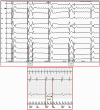Serendipitous Supernormality
- PMID: 40181525
- PMCID: PMC11968411
- DOI: 10.1111/anec.70069
Serendipitous Supernormality
Abstract
We describe a patient who underwent AV node modification to create complete heart block in the setting of incessant, ablation-and-drug-refractory, symptomatic atypical atrial flutter. His dual chamber defibrillator (previously implanted for resuscitated cardiac arrest) was programmed to the VVIR mode at a faster pacing rate of 85 bpm. Serendipitously, this rate was an almost exact factorial of his flutter rate of 250-260 bpm. This resulted in every 6th flutter wave falling in the supernormal period, resulting in fixed-coupled supraventricular bigeminy and trigeminy in the setting of complete heart block. Reprogramming the pacing rate to 75 bpm abolished bigeminy and trigeminy.
Keywords: atrioventricular node ablation; atypical atrial flutter; supernormal conduction.
© 2025 The Author(s). Annals of Noninvasive Electrocardiology published by Wiley Periodicals LLC.
Conflict of interest statement
The authors declare no conflicts of interest.
Figures






References
-
- Fisch, C. 1990. Electrocardiograph of Arrhythmias, 247. Lea & Febiger.
-
- Fisch, C. , and Knoebel S. B.. 1968. “Wedensky Facilitation in the Human Heart: Report of a Probable Case.” American Heart Journal 76, no. 1: 90–92. - PubMed
-
- Friedberg, H. D. 1971. “Mechanism of the Wedensky Phenomena in the Left Bundle Branch.” American Journal of Cardiology 27, no. 6: 698–702. - PubMed
-
- Gallagher, J. J. , Damato A. N., Varghese P. J., Caracta A. R., Josephson M. E., and Lau S. H.. 1973. “Alternative Mechanisms of Apparent Supernormal Atrioventricular Conduction.” American Journal of Cardiology 31: 362–371. - PubMed
-
- Kenia, A. S. , Ho R. T., and Pavri B. B.. 2014. “Narrowing With Prematurity‐What Is the Mechanism?” Pacing and Clinical Electrophysiology 37, no. 10: 1404–1407. - PubMed
Publication types
MeSH terms
LinkOut - more resources
Full Text Sources

